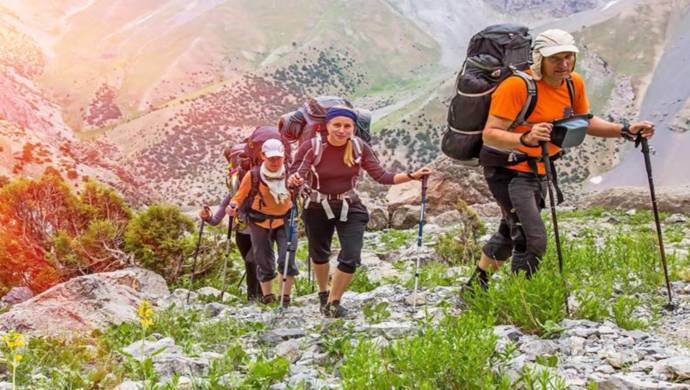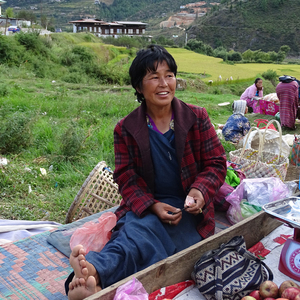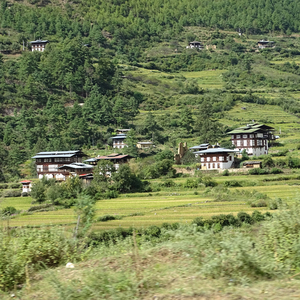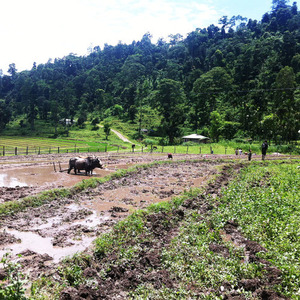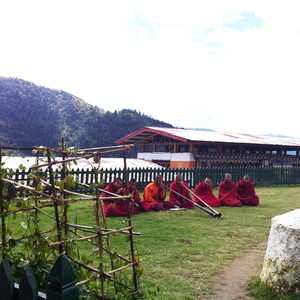Day 1. Paro - Thimphu:
Driving Distance: 65 Kms, Driving time: 1.50 hrs - 2 hrs, Altitude of Thimphu: 2,350 m
Your flight to Paro on a clear day, is marked with the panoramic views of the Himalayas including the Everest and other famous Peaks. The approach through the foothills and the landing (including few steep turns) at the tiny airstrip of Paro has been termed as adventurous by many travelers. After the completion of immigration formalities at the Paro Airport exit door, you will be received by your Bhutanese guide with traditional “Tashi Khadar”. Afterwards drive to Thimphu following the Pa Chhu River. Check-In to the hotel and have your first experience with Bhutanese Cuisine. Rest of the day is at leisure. You can explore the Thimphu valley and town or shop till your heart’s content. A private traditional Cultural Show would be organized especially for you in the evening.
Meals – Lunch and Dinner; Overnight at the Hotel in Thimphu.
Day 2. Thimphu Sightseeing:
Today you would be driven in and around Thimphu covering key places of interest. After breakfast you would visit
- Kuensel Phodrang, the gigantic Buddha Dordenma Statue located atop a hill in Kuensel Phodrang Nature Park.
- National Memorial Chhorten, a Stupa built in 1974 to honor the third Druk Gyalpo, Jigme Dorji Wangchuck. Every morning till night old people and young people circumambulate the Chhorten.
- Zorig Chusom, Premier institute of traditional arts and crafts in Thimphu built to preserve the “thirteen arts and crafts of Bhutan”.
- Folk Heritage, traditional house giving an insight to the Bhutanese lifestyle, and artifacts from the rural households
Thereafter you would be taken to a local restaurant for lunch. In the afternoon you would be taken to
- Sangaygang View Point, also known as BBS Tower offering panoramic view of Thimphu Town situated at an elevation of 2,685 m.
- Changangkha Monastery, popular fortress like temple perched on a ridge above Central Thimphu built in 15th Century by Lama Phajo Drugom Zhipo.
- Takin Preserve Centre, see Takin (National animal of Bhutan) It is a unique combination of Goat and an Antelope
- Tashichhodzong, or ‘the fortress of the glorious religion’. Initially erected in 1641 by Shabdrung Ngawang Namgyal, it was rebuilt in the 1960s during the reign of Bhutan’s third king in the traditional style, without plans or nails. It houses some ministries, His Majesty’s secretariat, and the central monk body and opens after 5 PM.
After the completion of sightseeing, you are driven back to your hotel. After relaxing for sometime you are served with dinner.
Meals – Breakfast, Lunch and Dinner; Overnight at the Hotel in Thimphu.
Day 3. Thimphu - Gangtey/Phobjikha:
Driving Distance: 140 Kms, Driving time: 4 hrs - 5 hrs, Altitude of Gangtey/Phobjikha: 2900 m
After breakfast and completion of check out formalities, you are driven to Gangtey/Phobjikha. On the way stop at
- Dochula Pass, lies at an elevation of 3,150 m and is a great place to view the higher Himalayas. The landmarks around the pass includes 108 Druk Wangyal Stupas built under the patronage of Queen Ashi Dorji Wangmo Wangchuk.
Thereafter, you continue your drive to Gangtey/Phobjikha. While in Gangtey, visit the
- Gangtey Goemba, an important monastery of Nyingmapa school of Buddhism, the main seat of the Pema Lingpa tradition. The present Abbot, Kunzang Pema Namgyal is the ninth re-incarnation. It is one of the the largest Nyingma monastery in Bhutan.
- Black Necked Crane Information Centre, a place for recreation with crane watching equipment (binoculars, spotting scopes) and reference books.
Lunch would be served at a local restaurant. After the completion of sightseeing, you are driven back to your hotel. After relaxing for sometime you are served with dinner.
Meals – Breakfast, Lunch and Dinner; Overnight at the Hotel in Phobjika/Gangtey.
Day 4. Gangtey/ Phobjikha Valley:
A full day to explore at the
- Phobjikha Valley, one of the most beautiful glacial valleys in the Himalayas. It lies at an elevation of 3,000 m. It is surrounded by a many small villages. Phobjikha is best known for the rare black necked cranes that migrate here from the Tibetan Plateau to avoid the extremely cold winters.
Lunch would be served in a local restaurant. You may choose to do any of the following: Visiting villages and interacting with People, Hikes around the valley, Photography, etc.
Meals – Breakfast, Lunch and Dinner; Overnight at the Hotel in Phobjika/Gangtey.
Day 5. Gangtey - Trongsa - Tongtongphey - Jangbi village:
Driving Distance 70 Kms; Driving Time 2 hrs.;
Walking Distance 7 kms; Walking time 2 hrs - 3 hrs, Altitude of Jangbi 1,350 m
After breakfast and 2 hours drive from the town brings you to the start of the Trek, Tongtongphey. On the way visit
- Kuenga Rabten Palace, the Winter Palace of the Second King. It was a large stone building built in the 19thC. As in all traditional buildings, the ground floor was used to store food. The royal attendants and army lived on first floor. The Royal apartments were on the second floor. The King lived in the right wing and his wives in the left wing. The palace became a monastery during the third King’s reign. About 30 very young monks live here and move to Trongsa when they are older.
After furnishing yourself with ample information about the trek from the information booth, the village guide steers you down to the Mangdi river where you cross a suspension bridge. On this stretch, it is almost impossible to miss out on Golden Langurs that are found in abundance here.
The first day brings you in contact with the Monpas who are believed to be the first inhabitants of Bhutan. A glimpse on their lifestyle further validates their ethnicity, coupled by mythical legends about their origins. The campsite in Jangbi stands on the valley sill, which offers a resplendent view of the Mangdi valley. If you still have some energy for locomotion, you could audience yourself to a local cultural program, or better, partake in it.
Meals – Breakfast, Lunch and Dinner; Overnight in the Camp.
Day 6. Jangbi village - Kudra village:
Distance: 12 kms, Time: 6 hrs., Altitude of campsite: 1,500 m
The morning allows you to further interact with the Monpas. Before you proceed, you could also pay a visit to the orchid garden that fences about 75 different kinds of orchids till your thirst for botanical photography gets satiated. The hike to Kudra provides a nuance of jovial atmosphere because this part of the trail meanders along stone imprints of Guru Rinpoche’s footprints, dagger and phallus, festooned by stories that espouse Guru’s praxis. Lunch is served just before you arrive at Phrumzur, one of the villages of the Monpas communities, off the trail. You could also visit the village Lhakhang in Phrumzur and then proceed to the campsite in Kudra. En route, you traverse another small Monpas village called Lekpogang, after which, the campsite in Kudra is just an hour’s walk. The campsite offers a bird’s-eye-view of Nyimshong village and also the Zhemgang town.
Meals – Breakfast, Lunch and Dinner; Overnight in the Camp.
Day 7. Kudra village- Nabji village:
Distance: 13 km, Time: 7 hrs, Altitude of campsite: 1,300 m
You wake up with the distant call of the Rufous-necked hornbill. This part of the trek is a collage of streams, waterfalls and thick forests that will give you an invigorating feeling of being out in the wild. The Great Himalayan Squirrel, Rhesus Mecaques, and small snakes are often spotted along the trail. Unseen but present, are Himalayan black bear, Red pandas, tigers, Clouded leopards et cetera. Upon arrival at the holy tree in Nabji, the people will give you a heartwarming reception. Nabji is a beautiful village where paddy fields seem to circumambulate the clustered houses. You could also hike to the community school and indulge yourself in game of football or volleyball, where children rejoice the presence of outsider athletes.
Meals – Breakfast, Lunch and Dinner; Overnight in the Camp.
Day 8. Nabji village - Korphu village:
Distance: 3 kms, Time: 2 hrs., Altitude of campsite: 1,500 m.
En route to Korphu, the Nabji temple is located in the middle of the paddy fields. Inside, there remains a stone pillar on which Guru Rinpoche, while traveling through Bhutan in the 8th century, brought consensus between the warring kings: King Sindha Gyalpo of Bumthang, and King Noeche, by imprinting their thumbs on each side of the stone. A unique festival is celebrated sometime in early January at the temple grounds. Korphu is situated on a mountaintop at an altitude of 1,500m. The most striking thing about Korphu is that the people exemplify hospitality almost treating you like ‘A King on accession to throne’. You have the option of being welcomed with a traditional ‘Chipdrel’ procession and a ‘Marchang’ ceremony, singing traditional songs of praise and wellbeing for new visitors. They also perform the traditional ‘Tashi Labey’ dance to bid you farewell. If you are interested, the villagers can explain and demonstrate and even allow you to participate in the quintessential Bhutanese games of ‘Khuru’, ‘Dego’, ‘Sok-sum’, and ‘Gee-dum’, all on the brink of disappearance. You could also pay a visit to the village temple that houses the sacred relics of Pema Lingpa, the famous ‘Treasure revealer’ of Bhutan. A local lunch could be provided in the village campsite which also provides a spectacular bird’s-eye view of Nabji and other surrounding areas.
Meals – Breakfast, Lunch and Dinner; Overnight in the Camp.
Day 9. Korphu village - Nimshong village:
Distance: 8 kms, Time: 4 hrs., Altitude of campsite: 1,300 m
The hike from Korphu to Nyimshong is the pleasant and arguably the best birding spot which can boast a bird list of more than 395 species. The elusive Rufous Necked Hornbill has its nesting holes adjacent to the trail. The walk is mixed with waterfalls and, streams and cantilever bridges. The evening brings you to Nyimshong, a village with its reticent architecture and lifestyle. The campsite is equipped with an amphitheater. The women of Nyimshong have a penchant for singing and dancing and a cultural show would be ideal to express certain euphoria to end your trek.
Meals – Breakfast, Lunch and Dinner; Overnight in the Camp.
Day 10. Nimshong village - Riotala - Trongsa town:
Walking distance: 5 km, Walking time: 3 hours, Altitude of Riotala: 1,000 m
If you are lucky the golden Langurs will lead you to the exit. You descend down to Mangdue River to see some herons and river lapwings. An Hour’s steep ascend to the road and your vehicle will be waiting for you. Drive to Trongsa.
Meals – Breakfast, Lunch and Dinner; Overnight at the hotel in Trongsa.
Day 11. Trongsa - Bumthang:
Distance: 68 kms, Driving Time: 2 hrs - 3 hrs, Altitude of Bumthang: 2600 m.
After breakfast, visit
- Trongsa Dzong, the seat of power over Central and Eastern Bhutan. It was built by Chogyal Minjur Tempa was later enlarged at the end of the 17th century by Desi Tenzin Rabgay. Trongsa Dzong is the ancestral home of the present Royal Family. The first two hereditary kings ruled Bhutan from this Dzong.
- Ta Dzong, an ancient watch tower built in the year 1652 by Chogyal Minjur Tempaa as per the directions of Shabdrung Ngawang Namgyal. It has been converted into a museum and represents a tasteful blend of tradition and modernity.
Later drive to Bumthang over the Yutong-La-Pass (11,155 ft.). enroute stop for lunch. While in Chumey valley in Bumthang, visit the.
- Yathra Weaving Factory, located in the Zungye village in Chumey, around 17 kms approximately, before reaching the main town of Bumthang. Yathra is the most famous textile product of Bumthang. Yathra is a hand woven fabric made from the wool of sheep or Yak.
On arrival check in at the hotel. Evening free for leisure and walk in the valley.
Meals – Breakfast, Lunch and Dinner; Overnight at hotel in Bumthang.
(Note: the roads to Bumthang are not good due road widening work going on)
Day 12. Bumthang Sightseeing:
After breakfast, you would be taken around the city to visit the
- Jakar Dzong, literally meaning the Castle of White Bird. The current structure was built in 1667. Jakar Dzong is now the main administrative center for Bumthang District, the Dzong also houses the regional monk body.
- Jambay Lhakhang, built by King Srongsen Gampo of Tibet in the 7th century and is one among the 108 monasteries built by him to subdue evil spirits in the Himalayan Region. October one of the most spectacular festival, “Jambay Lhakhang Drup” is staged here.
- Chakhar Lhakhang, literally meaning the Iron Castle. The original palace was made of Iron and hence the name “Chakhar”. It was rebuilt in 14th century by Dorji Lingpa, a Buddhist saint.
- Kurjey Lhakhang, named after body print of Guru Rimpoche. It consists of three temples. The first temple was built in the year 1652 on the rock face, where Guru Padmasambhava meditated in the 8th century. The second temple is considered to be the most holy as it is built on the site of the cave which contains the imprint of the Guru's body. In the year 1990, Ashi Kesang, the Queen mother built the third temple. All the three temples are surrounded by 108 chorten wall.
Thereafter you would be taken to a local restaurant for lunch. In the afternoon you would be taken to
- Tamshing Lhakhang, literally meaning the Temple of the good message. It was established in 1501 by Terton Pema Lingpa and has ancient religious paintings such as 1000 Buddhas and 21 'Taras' (female form of Bodhisattva).
- Membar Tsho, also known as “The burning Lake”. It is one of the most sacred sites in the region and relates to the famous treasure revealer, Terton Pema Lingpa. Following a prophecy by Guru Rinpoche, Terton Pema Lingpa unearthed a treasure from the bottom of the lake. He dived into the lake with a burning butter lamp and reappeared with the butter lamp still burning and a chest and scroll of paper in his hand (treasures)
The evening ends with a visit the cheese and apple juice/wine making factory. You have the option of Tasting the Locally made Red panda beer here. Finally, after a culturally fruitful day, you are driven back to the hotel.
Meals – Breakfast, Lunch and Dinner; Overnight at hotel in Bumthang.
Day 13. Bumthang - Punakha/Wangdue:
Distance: 220 kms, Driving Time: 8 - 9 hrs. Altitude of Punakha: 1310 m.
After breakfast, check out from hotel and drive to Punakha/Wangdue. On the way stop for Lunch. After arrival check into the hotel. Evening free for leisure.
Meals – Breakfast, Lunch and Dinner; Overnight at Hotel in Punakha/Wangdue.
Day 14. Punakha/Wangdue Sightseeing: :
After breakfast, you would be visiting
- Khamsum Yulley Namgyel Monastery, a monastery that stands majestically on a strategic ridge above the Punakha valley. Built over a period of 9 years, Bhutanese craftsmen consulted holy scriptures rather than engineering manuals, to construct this 4-storey temple. It takes an hour to hike to the Temple passing through rice fields on the way.
Post Lunch, visit
- Punakha Dzong, built in 1637 by Shabdrung Ngawang Namgyal. For many years until the time of the second King, it served as the seat of the Government. It is still the winter residence of Je-Khenpo (The Chief Abbot of the Central Monastic Body of Bhutan)
- Chhimi Lhakhang, a famous Temple, which is also known as “The Temple of Fertility” built by Lama Drukpa Kuenley
After Chhimi Lhakhang, you would come back to your hotel. Evening free for leisure.
Meals – Breakfast, Lunch and Dinner; Overnight at Hotel in Punakha/Wangdue.
Day 15. Punakha - Paro:
Driving Distance: 135 kms, Driving Time: 4 hrs - 5 hrs, Altitude of Paro: 2280 m
After breakfast, you would check out of the hotel to proceed to Paro, final leg of the tour. On the way stop at
- Royal Botanical Park, Lamperi, also known as the Rhododendron Garden, is the first Botanical Garden of Bhutan. It is famous for 46 species of rhododendrons.
After arriving at Paro, you would be transferred to you Hotel for Check In. After lunch, you would be taken around to visit
- Paro Rimpung Dzong, also known as Fortress of the heap of jewels, built during the time of Shabdrung Ngawang Namgyal in 1646.
- Ta Dzong, an ancient watch tower overlooking Rimpung Dzong built in 1951 now converted into national museum.
Evening is free for leisure activities and shopping.
Meals – Breakfast, Lunch and Dinner; Overnight at the Hotel in Paro.
Day 16. Paro Sightseeing:
After breakfast, start your day with a hike to
- Taktsang Monastery (Tiger's nest), the abode of gods and monks situated at an altitude of 3100m on the Upper Paro Valley, Bhutan. As per the legend, Guru Padmasambhana (Guru Rinpoche), the tantrum mystic who brought Buddhism to Bhutan, came in the form of Dorje Droloe riding a flying tigress to subdue the demon that was obstructing the spread of Buddhism in the Himalayas.
After the completion of the hike, you would be served picnic Lunch among the woods. After lunch, visit
- Kyichu Lhakhang, one of the oldest monasteries in Bhutan built in the 7th century by the Tibetan Emperor Songtsen Gampo.
You would then drive to village house to witness the traditional rural life in a Bhutanese village. Also you have an option of experiencing a Traditional Hot Stone bath in the village house. You can also choose to have your dinner in the house with the Family (needed to be confirmed at the time of confirmation of the Tour) or be driven back to your hotel.
Meals – Breakfast, Lunch and Dinner; Overnight at the Hotel in Paro.
Day 17. Departure:
Today we will bid farewell to this beautiful country and take an early flight back. We hope by now you mist have made some good friends and also have taken photographs and beautiful memories of Bhutan. We certainly hope of serving you again on your next visit to this great country or the Last Shangri-La. Tashi Delek.
